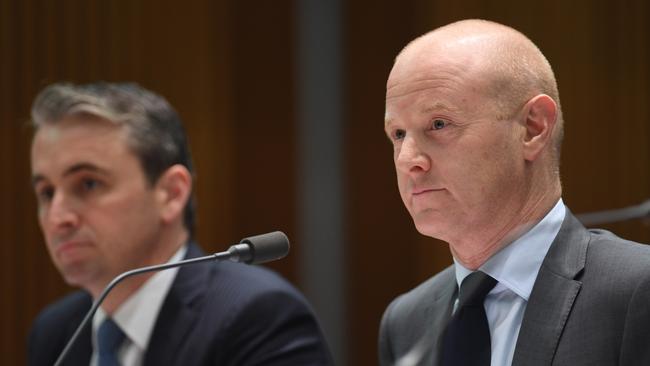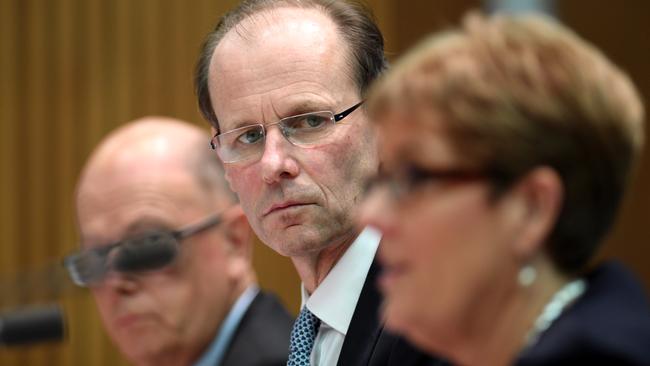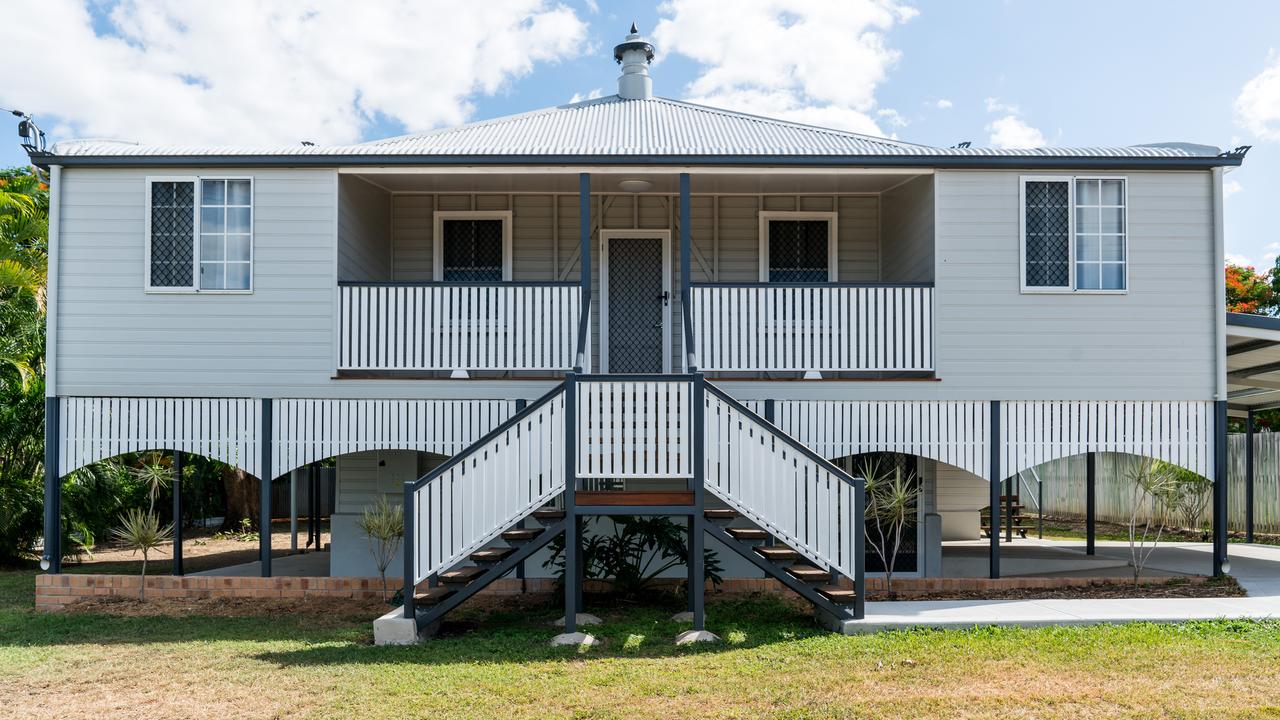CommBank, ANZ bosses grilled by parliament
COMMBANK has been accused of orchestrating a “cover-up” like something out of Yes Minister over its scandal-plagued CommInsure arm.

THE Commonwealth Bank’s much criticised report into its scandal-plagued CommInsure arm has been likened to an episode of Yes Minister by a parliamentary committee.
Deloitte’s report, released last week, came under widespread criticism for clearing CommBank’s insurance business of “systemic” cultural problems, despite not interviewing a single affected customer.
Appearing before the House of Representatives Economics Committee on Tuesday, CommBank chief executive Ian Narev defended the report — one of three commissioned by the bank — as “robust and independent”.
CommBank has declined to publicly release the other two reports, by law firm DLA Piper and accounting firm Ernst & Young, claiming legal privilege. The reviews came after investigations by the ABC and Fairfax revealed cases of claims being delayed or denied for terminally ill people.
In a blistering attack, the committee’s deputy chair, Labor MP Matt Thistlethwaite, described the report as “noxious” and accused the bank of a “cover-up”.
“You’ve got a report based on victims, that’s arisen because the victims have been denied claims, but don’t interview anyone covered by the policies,” he said. “That’s noxious. It reminds me of Jim Hacker in Yes Minister visiting St Edwards, a hospital that had no patients.
“You should call this the St Edwards report. It beggars belief.”
Mr Narev replied that “for the purposes of the report”, the conclusion was that “speaking to customers was not necessary”. “Deloitte had unfettered access to all sorts of customers’ records,” he said. “A very large number of staff [were interviewed]. It does make sense given the nature of the insurance business.
“We’re dealing with customers’ experiences, medical reports, hundreds of thousands were reviewed. The review was done to very rigorous methodology and reached very clear conclusions.”
Mr Thistlethwaite accused CommBank of “stacking the figures”. “Of TPB [total permanent disability] claims, 217 of 2172 were reviewed [for the report], about 10 per cent, but 98 per cent of death claims were reviewed. [But] it is well known in the industry that TPB claims have a higher denial rate,” he said.
“Death claims are the least disputed area of claims for obvious reasons. That’s not a fair representation, is it, given you’ve basically stacked the figures to ensure the outcome was favourable to your organisation?”
Mr Narev said Deloitte was an “independent expert who believed the sample was robust”, adding that the regulator, the Australian Prudential Regulation Authority, had supported the report.
Mr Thistlethwaite accused CommBank of hiding behind Deloitte. “You find an organisation to hide behind to back you up, claim legal privilege on documents, it’s more of this cover-up,” he said.
In response, Mr Narev said the conclusions of the DLA Piper and Ernst & Young reports were “manifestly at odds” with claims of wrongdoing, and “our preference would always be to release them”.
“I think you would understand that individuals have provided information [for those reports] based on a certain understanding of how that information is used, and they would not want us to breach their trust,” he said.
Other issues covered during the committee’s questioning included credit card interest rates, negative gearing, poor financial advice and CommBank’s opposition to a banking royal commission.
Mr Narev said the bank didn’t support “tinkering” with individual policies such as negative gearing to address housing affordability, warning it could cause short-term distortions in the housing market.
“We believe supply-side and demand-side characteristics should be taken into account,” he said. “The starting point needs to be the wellbeing of Australians. Too many of the debates we’ve heard have been focused on individual policies.”
Mr Narev added that CommBank had “no plans at this stage” to follow its subsidiary Bankwest in removing negative gearing tax breaks from its loan eligibility assessment checklist.
Quizzed by Liberal MP Scott Bucholz on why credit card interest rates are so high, Mr Narev said CommBank did not set its competitive position on “being the cheapest”. CommBank’s “low-rate” card is currently 13.42 per cent — nearly 2 per cent higher than the ANZ — its “low-fee” card is 19.74 per cent, and its “awards” card is 20.24 per cent.
“For those people solely concerned about their rate, if we’re not the cheapest in the market, they will make the decisions they will make in a competitive market,” he said.
Retail banking head Matt Comyn added that CommBank was “in the process of making it very easy” for customers to switch to ANZ or another credit card provider.
“They will be able to close their account online with a few clicks with no interaction with a person,” he said. He added that high rates were justified by the bank’s recent $650 million loan impairment expense.
“The vast majority of that relates to consumer finance,” Mr Comyn said. “So even in very benign consumer conditions, we experience hundreds of millions of dollars in loss.”

ANZ PRAISED FOR CUTTING RATES
Appearing before the committee in the afternoon, Mr Bucholz praised ANZ chief executive Shayne Elliott for cutting credit card interest rates since the previous grilling in October.
Last month, the bank announced that it would reduce the rate on its “low-rate” card by 200 basis points to 11.49 per cent. The bank said the move would affect more than 500,000 customers and save them an average of $150 a year on interest.
Mr Elliott said since the announcement ANZ had seen a 20 per cent increase in applications for the low-rate card. “We have 15 per cent market share, we fight really hard to grow that and it’s hard work,” he said.
Mr Elliott said the large amount of churn in the industry highlighted the competitive pressures. “We have five million different customers, half a million of them a year decide to go somewhere else,” he said. “We’re fortunate that 600,000 customers come from somewhere else.”
Asked whether the bank would consider launching “tracker” mortgages linked to the official cash rate, Mr Elliott said internal research showed only 10 per cent of current variable rate customers would switch to a tracker.
He said the tracker mortgages would be “commercially unattractive” and would make ANZ’s business more complicated. “That said we will continue to assess demand,” he said.
Mr Thistlethwaite also quizzed ANZ’s execs on former ANZ financial planner Andrew TambyRajah, who in December was banned by ASIC from providing financial services for five years.
ASIC found Mr TambyRajah engaged in misleading and deceptive conduct by creating false documents and falsely amending documents contained on client file.
That included “writing clients’ names and initials on documents in the places designated for their signatures and initials, changing the dates recorded on a number of documents, and creating false investor profile forms for two clients by photocopying forms they had signed in previous years and changing the dates on the copied documents”.
The Labor MP revealed he had been browsing the former ANZ employee’s LinkedIn profile. “He’s quite proud of the work he did with you,” Mr Thistlethwaite said. “He [writes that] he completed and passed all annual audits from 2006 to 2014, and mentored seven other people.”
Mr Elliott replied that “people say all sorts of things on their LinkedIn profiles so we need to go and see if that corresponds to the facts”.
“There’s no reason to believe he wasn’t a good employee for some of that period, but he broke the rules, and when we discovered that we terminated his employment,” he said.
Asked whether ANZ had reviewed the seven associates he mentored, Mr Elliott said the bank had been “extensively reviewing all of our planner network”. “They’re under far more oversight than they ever have been,” he said.
“We do a lot of that digitally now, we use data analytics and do far more auditing.”
The hearings were sparked following community uproar last August over the banks’ failure to pass on the Reserve Bank interest rate cut.
The first hearings were held in October, with a report making 10 recommendations for changes to law. Last week, the head of NAB appeared before the committee, where he was grilled over poor conduct of the bank’s financial planning arm.
The committee is chaired by Liberal Party backbencher David Coleman. Westpac head Brian Hartzer and Australian Banking Association CEO Steven Munchenberg are set to appear on Wednesday.




